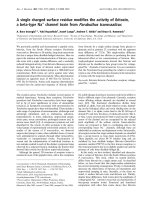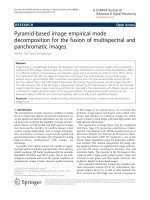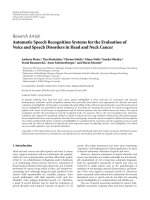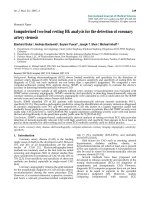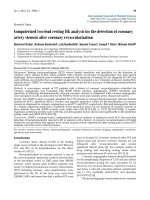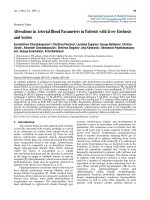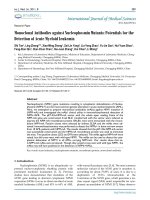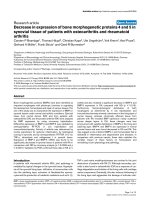Báo cáo y học: "Mortality in COPD patients discharged from hospital: the role of treatment and co-morbidity" potx
Bạn đang xem bản rút gọn của tài liệu. Xem và tải ngay bản đầy đủ của tài liệu tại đây (275.51 KB, 8 trang )
BioMed Central
Page 1 of 8
(page number not for citation purposes)
Respiratory Research
Open Access
Research
Mortality in COPD patients discharged from hospital: the role of
treatment and co-morbidity
Gunnar Gudmundsson*
1
, Thorarinn Gislason
1
, Eva Lindberg
2
, Runa Hallin
2
,
Charlotte Suppli Ulrik
3
, Eva Brøndum
3
, Markku M Nieminen
4
, Tiina Aine
4
,
Per Bakke
5
and Christer Janson
2
Address:
1
Department of Respiratory Medicine, Allergy and Sleep, Landspitali-University Hospital, Reykjavik, Iceland,
2
Department of Medical
Sciences: Respiratory Medicine and Allergology, Uppsala University, Akademiska Sjukhuset, Uppsala, Sweden,
3
Department of Respiratory
Diseases, Hvidovre Hospital, University of Copenhagen, Copenhagen, Denmark,
4
Department of Respiratory Medicine, Tampere University
Hospital, Tampere, Finland and
5
Haukeland University Hospital, Bergen, Norway
Email: Gunnar Gudmundsson* - ; Thorarinn Gislason - ;
Eva Lindberg - ; Runa Hallin - ; Charlotte Suppli Ulrik - ;
Eva Brøndum - ; Markku M Nieminen - ; Tiina Aine - ;
Per Bakke - ; Christer Janson -
* Corresponding author
Abstract
Background: The aim of this study was to analyse mortality and associated risk factors, with
special emphasis on health status, medications and co-morbidity, in patients with chronic
obstructive pulmonary disease (COPD) that had been hospitalized for acute exacerbation.
Methods: This prospective study included 416 patients from each of the five Nordic countries that
were followed for 24 months. The St. George's Respiratory Questionnaire (SGRQ) was
administered. Information on treatment and co-morbidity was obtained.
Results: During the follow-up 122 (29.3%) of the 416 patients died. Patients with diabetes had an
increased mortality rate [HR = 2.25 (1.28–3.95)]. Other risk factors were advanced age, low FEV
1
and lower health status. Patients treated with inhaled corticosteroids and/or long-acting beta-2-
agonists had a lower risk of death than patients using neither of these types of treatment.
Conclusion: Mortality was high after COPD admission, with older age, decreased lung function,
lower health status and diabetes the most important risk factors. Treatment with inhaled
corticosteroids and long-acting bronchodilators may be associated with lower mortality in patients
with COPD.
Background
Chronic Obstructive Pulmonary Disease (COPD) is asso-
ciated with intermittent exacerbations characterized by
acute deterioration in the symptoms of chronic dyspnea,
cough and sputum production. Worldwide, COPD is the
only leading cause of death that still has a rising mortality
rate. It has been estimated that by the year 2020 COPD
will be the third leading cause of death in the world [1].
Hospitalizations because of acute exacerbations are an
important part of the care of patients with COPD. Further-
Published: 16 August 2006
Respiratory Research 2006, 7:109 doi:10.1186/1465-9921-7-109
Received: 03 March 2006
Accepted: 16 August 2006
This article is available from: />© 2006 Gudmundsson et al; licensee BioMed Central Ltd.
This is an Open Access article distributed under the terms of the Creative Commons Attribution License ( />),
which permits unrestricted use, distribution, and reproduction in any medium, provided the original work is properly cited.
Respiratory Research 2006, 7:109 />Page 2 of 8
(page number not for citation purposes)
more, they are associated with further impairment of
health status [2] and high cost [3]. Studies on mortality
after hospitalization for an acute exacerbation of COPD
have shown a one-year mortality from 22% [4] to 43% [5]
and a 2-year mortality of 36 [6] to 49% [5].
Several studies have been conducted in order to identify
the risk factors of mortality in COPD and there is a con-
comitant increasing interest in modifying the risk factors
in order to reduce mortality. Among risk factors that have
been identified in previous studies are increasing age, a
higher PCO
2
, long-term use of oral corticosteroids [4],
reduced health status, marital status, depression, co-mor-
bidity and prior hospital admission [6]. There are limited
data available regarding the relationship of inhaled med-
ications to mortality. A retrospective study by Soriano et
al. showed that outpatients treated with a combination of
inhaled corticosteroids and long-acting beta agonists or
inhaled corticosteroids alone had a lower mortality rate
than those that were not so treated [7].
The aim of this study was to analyse prospectively mortal-
ity in COPD patients after hospitalisation and associated
risk factors, with special emphasis on health status, medi-
cations and co-morbidity.
Methods
This prospective study of patients hospitalised with acute
exacerbations of obstructive airway disease in five univer-
sity hospitals in the Nordic countries has been described
previously [8,9].
The departments included were: The Department of Res-
piratory Medicine and Allergology, Akademiska sjukhu-
set, Uppsala, Sweden; The Department of Thoracic
Medicine, Haukeland University Hospital, Bergen, Nor-
way; The Department of Respiratory Medicine, Tampere
University Hospital, Tampere, Finland; The Department
of Respiratory Medicine, Vifilstadir University Hospital,
Gardabaer, Iceland; and The Department of Respiratory
Medicine, Hvidovre Hospital, Copenhagen Denmark. An
Internal Review Board in each centre or country approved
the study.
Consecutive patients from each of the participating hospi-
tals were included, provided that they had been admitted
with acute exacerbations of COPD during 2000–2001. An
acute exacerbation was defined as a change in condition
in a COPD patient from baseline that was of such a mag-
nitude that the patient needed an acute hospital admis-
sion. All patients fulfilled the criteria for COPD according
to stage 1 or higher of the Global Initiative for Chronic
Obstructive Pulmonary Disease [10]. All records were
reviewed by the investigators to confirm the diagnosis and
GOLD criteria were used to diagnose COPD. Patients
thought to have asthma were excluded. Only patients who
were admitted for more than 24 hours were included. All
patients signed an informed consent before entering the
study.
The following data were collected at discharge from the
respective pulmonary departments. Information was col-
lected in a similar fashion on standardized data sheets in
all the departments. All data were entered at one centre.
1. Questionnaire that included information on smoking
history, type of living, and family situation (alone or with
others).
2. Spirometry, body weight and height. Predicted values
for forced expiratory volume in one second (FEV1) and
forced vital capacity (FVC) were calculated based on the
European Coal and Steel Union reference values [11].
COPD severity was calculated according to the GOLD-cri-
teria [10].
3. Health status (quality of life) was assessed using the dis-
ease-specific St George's Respiratory Questionnaire
(SGRQ). It has three components: symptoms, activity and
impact, in addition to total score [12]. Higher scores indi-
cate worse health status.
4. From the patients' records information was collected on
treatment at discharge, including long-term oxygen ther-
apy. The patients were categorized in four treatment cate-
gories based on the utilization of inhaled corticosteroids
(ICS) and long-acting beta-2-agonists (LABA): none, only
LABA, only ICS and both LABA and ICS [7]. Assessment of
co-morbidity was based on the diagnosis used by the
treating physician. Diabetes mellitus was considered to be
present if the patient was using medication for diabetes.
Hypertension, ischemic heart disease or atrial fibrillation
was considered to be present when diagnosed by attend-
ing physician.
5. Two years after discharge information regarding death
and causes of death was obtained from the National Reg-
istries in each country. The primary (underlying) cause of
death was divided into the following categories: Respira-
tory causes [acute COPD exacerbations (ICD 10 code
J44.0 and J44.1), respiratory insufficiency (J96) and pneu-
monia (J12-J18)]; Cardio-vascular causes [myocardial inf-
arction (I21), heart failure (I50), stroke (I61 and I63) and
rupture of aortic aneurysms (I71)]; Malignancy [lung can-
cer (C34), leukaemia (C91), lymphoma (C85) and
abdominal tumour (D37)] and Other [septic shock (R57),
aspiration (J69) and ileus (K56)].
Respiratory Research 2006, 7:109 />Page 3 of 8
(page number not for citation purposes)
Statistics
Analyses were carried out using Stata 8.0 (Stata Corpora-
tion, College Station, Texas). The chi-square test and the
unpaired t-test were used when comparing patients that
had died during the study period. The relationshipbe-
tween survival time and patient characteristics was deter-
minedwith Kaplan-Meier survival analysis and Cox
regression. Multivariate analyses also were carried out
with theCox model after adjustment for FEV
1
. The ana-
lysed independent variableswere chosen based on statisti-
cal significance in the bivariateanalyses and on clinical
relevance. Age, FEV
1
and health status were entered as con-
tinuous variables, while gender, smoking status, previous
hospitalizations, co-morbidity and treatment were
entered as categorical variables. The proportional hazard
assumption was tested for all the independent variables in
the models and no violation was detected (p > 0.1). The
effect of the pharmacological treatment at discharge was
primarily assessed by entering the four LABA and ICS ther-
apy categories and long-term oxygen to the model above.
Other therapies were thereafter entered one at a time to
the model. In order to detect heterogeneity between the
hospitals concerning determinants for mortality the Cox
regression estimates (hazard ratio) were also calculated by
hospital and then combined, using random effect meta-
analysis. A p-value of < 0.05 was considered statistically
significant.
Results
A total of 416 patients who were hospitalized for an acute
COPD exacerbation between January 2000 and December
2001 were included in the study. During the two-year fol-
low-up 122 (29.3%) of the 416 patients died. The primary
cause of death was respiratory in 79 patients, cardiovascu-
lar in 21, malignancy in 7, other causes in 3 patients,
whilst no information on causes of death was available for
12 patients. The patients that died were older, more often
men, had worse lung function, and more often had a his-
tory of previous hospitalizations (Table 1). They also had
a worse health status, both for total score and individual
components. Patients with diabetes had a higher mortal-
ity rate (Figure 1).
Mortality was related to older age, lower lung function,
lower health status and diabetes, as shown in Table 2.
Older age and diabetes were related to both respiratory
and cardiovascular mortality. In addition respiratory mor-
tality was related to lower lung function.
Table 3 compares medical treatment between the surviv-
ing and non-surviving groups. Treatment with inhaled
corticosteroids and/or long acting beta-adrenergic inhal-
ers was associated with decreased mortality compared to
the group of seventy-four patients that were on neither of
these types of therapy at discharge (Figure 3, Table 3).
Nebulized bronchodilators and long-term oxygen use
were also associated with increased mortality in the bivar-
iate but not in the multivariate analyses. The group of
patients that were not using inhaled corticosteroids or
long-acting beta-adrenergics had a significantly lower
usage of oral theophylline (17.6 vs. 29.5%, p = 0.03) than
the groups of patients that were taking inhaled corticoster-
Table 1: Differences between dead and surviving patients (mean ± SD or %).
Alive (n = 294) Dead (n = 122) p-value
Age (years) 68.2 ± 10.9 72.1 ± 8.7 0.0005
Women 54.146.60.03
Current smokers 24.6 28.7 0.39
Pack years 35.7 ± 24.5 34.3 ± 19.8 0.59
Living alone 52.6 50.8 0.74
FEV
1
(% pred) 40.6 ± 19.2 33.5 ± 14.4 0.0005
≥ 2 hospitalizations in previous 12 months 30.2 52.0 <0.0001
Health status (SGRQ)
Symptoms 63 ± 20 69 ± 16 0.006
Activity 65 ± 22 72 ± 20 0.002
Impact 44 ± 19 51 ± 19 0.001
Total 56 ± 17 63 ± 16 0.0002
Co-morbidity
Cardio-vascular disease 42.9 50.0 0.18
Diabetes 8.5 15.6 0.03
COPD severity according to the GOLD classification (12) 0.006
GOLD stage I-II 28 15
GOLD stage III 31 29
GOLD stage IV 41 57
Respiratory Research 2006, 7:109 />Page 4 of 8
(page number not for citation purposes)
oids and/or long-acting beta-adrenergics, whereas no
other differences were found concerning other types of
maintenance therapy between these patient groups.
No between-hospital heterogeneity was found in the asso-
ciation with the above risk factors and mortality when
studied using meta-analysis (p for heterogeneity >0.1 in
all analyses).
Discussion
The present study is the first one to our knowledge to
show that diabetes is a risk factor for mortality after hos-
pitalization for an acute exacerbation of COPD. It is also
the first prospective study to indicate that treatment with
long-acting beta-agonists and inhaled corticosteroids is
associated with lower mortality after hospitalization.
In the present study diabetes co-morbidity was related to
a higher mortality rate. Studies have shown that hospital-
ized patients with diabetes have a high mortality rate. Pre-
vious studies have shown that patients with diabetes had
a higher mortality rate after acute myocardial infarction
[13] and cardiogenic shock [14] than did non-diabetic
patients. Studies on COPD patients on co-morbidity and
the relation to mortality have shown conflicting results.
Almagro et al. [4] found a relation, whereas Groenewegen
and co-workers [6] and Incalz and co-workers did not
[16]. These studies all used the Charlson index for defin-
ing co-morbidity. Yohannes and co-workers did not find
a relation with co-morbidity in elderly outpatients [16].
Connors et al. showed the influence of congestive heart
failure and cor pulmonale on shortening survival time [5].
In our study cardiovascular co-morbidity was a risk factor
only in those patients with lower health status (data not
shown). Low health status had a stronger relation to car-
diovascular than respiratory mortality, thus indicating
that, in addition to COPD, cardiovascular co-morbidity
adds to lower health status.
In the present study the use of inhaled corticosteroids and
long-acting beta-adrenergic inhalers was associated with
decreased mortality. A study by Soriano et al. on a total of
4665 outpatients from a general practice database showed
three year survival to be higher in those 1045 patients who
were regular users of inhaled corticosteroids alone or in
combination with long-acting beta-adrenergic inhalers
after adjustment for age, sex, smoking, co-morbidites and
asthma [7]. His research was a retrospective study of out-
patients with less severe COPD. Using a database of
22,620 patients Sin and Tu found that inhaled corticoster-
oids lowered the risk ratio for all causes of mortality by
29% in patients after hospitalization for COPD [19]. They
also found that the use of oral corticosteroids was related
to increased mortality, whereas bronchodilators had no
effect on mortality [17]. It is of interest that our prospec-
tive study partly supported the results of these two retro-
spective studies as well as a more recent one [18]. In
contrast to the previous studies we also found that the use
of long-acting bronchodilators alone was related to a
decrease in the mortality rate.
One advantage of the present study is that medication was
assessed at discharge only, which avoids the problem with
immortal time bias [19]. This has been reported as an
Table 2: Risk of dying in relation to primary cause of death. Cox regression, Hazard Risk ratio* and 95 % confidence interval.
All deaths Respiratory Cardiovascular
Age (10 years) 1.49 (1.17–1.90) 1.45 (1.07–1.97) 2.62 (1.35–5.10)
Women 0.67 (0.44–1.03) 0.70 (0.41–1.21) 0.89 (0.32–2.48)
Current smoking 1.47 (0.91–2.38) 1.73 (0.97–3.10) 0.93 (0.18–4.86)
FEV
1
(per 10% pred. change) 0.83 (0.71–0.96) 0.76 (0.62–0.92) 0.87 (0.61–1.25)
≥ 2 previous hospitalizations 1.22 (0.79–1.90) 1.33 (0.77–2.30) 1.35 (0.43–4.22)
SGRQ score (4 units)
Symptoms** 1.04 (0.99–1.09) 1.03 (0.96–1.10) 1.06 (0.95–1.17)
Activity** 1.03 (0.98–1.08) 0.99 (0.93–1.04) 1.12 (0.98–1.28)
Impact** 1.06 (1.01–1.11) 1.07 (1.00–1.14) 1.09 (0.97–1.22)
Total score 1.07 (1.01–1.14) 1.05 (0.97–1.14) 1.14 (0.99–1.32)
Co-morbidities
Diabetes 2.25 (1.28–3.95) 2.42 (1.18–4.96) 3.82 (1.15–12.8)
Cardio-vascular disease 1.43 (0.92–2.23) 1.52 (0.87–2.65) 1.96 (0.65–5.92)
COPD severity according to the GOLD classification (12)***
GOLD stage I-II 1 1 1
GOLD stage III 1.18 (0.63–2.20) 1.09 (0.46–2.57) 0.69 (0.16–2.88)
GOLD stage IV 1.81 (1.02–3.24) 2.40 (1.13–5.12) 1.05 (0.27–4.06)
* adjusted for centre and the variables in the table
** entered separately, replacing SGRQ or HAD total score
*** entered separately, replacing FEV
1
Respiratory Research 2006, 7:109 />Page 5 of 8
(page number not for citation purposes)
important methodological issue in previous studies and
subsequent studies have dealt with this point and not
found survival benefits from inhaled corticosteroids [19-
21]. A disadvantage is that we have no information on
changes in therapy during the observation period. It
should, however, be stated that both the present and the
previous studies are observational and that a large rand-
omized controlled study is needed to prove that COPD
mortality can be reduced with inhaled corticosteroids
and/or long-acting bronchodilators [22].
In the present study lower health status was related to
higher mortality. This was true both for total score on the
SGRQ and for the three subscales of activity, impact and
symptoms. In the study by Almagro et al. the total score
and the activity scale on the SGRQ showed a statistical dif-
ference [4]. A study by Fan and co-workers showed that
those with the lowest quartile of physical function had a
higher mortality during a one-year follow-up in an outpa-
tient population [23]. A study by Oga of 150 male outpa-
tients with COPD in Japan found that total score, activity
and impact were related to mortality, whereas symptoms
were not [24]. A study by Domingo-Salvany et al. on male
outpatients reported that SGRQ and SF-36 total scores
were independently associated with total mortality and
respiratory mortality. [25]. Dyspnea was related to mortal-
ity in a study population that was followed after outpa-
tient pulmonary rehabilitation [28]. In accordance with
other studies we found that higher age [4-6,27] and worse
lung function were related to an increased mortality rate
[5,27]. There is an increasing interest in modifying risk
factors in order to decrease hospital admissions and mor-
tality. Several studies have shown that to be possible.
Increasing physical activity has been shown to decrease
both [29].
The mortality rates that we found following hospital
admission for an exacerbation of COPD were slightly
lower than in other reports. In a cohort of 1016 patients
in the United States there was 43% mortality after one
year and 49% after two years [5]. Groenewegen et al.
found 23% mortality one year after hospitalization in 171
patients in the Netherlands [6]. A study from Spain on
124 men and 11 women showed a one-year mortality rate
of 22% and a two-year mortality rate of 35.6% [4]. The
lower mortality rate in our study may be explained by the
fact that we studied different populations than in the
other studies.
In the present study most of the 122 patients died from
respiratory causes, a result that is similar to other studies
[16,28]. A study of 215 COPD patients on LTOT found
Kaplan-Meier survival curve in patients with higher (total SGRQ score ≤ 60) and lower health status (total SGRQ score > 60)Figure 1
Kaplan-Meier survival curve in patients with higher (total SGRQ score ≤ 60) and lower health status (total SGRQ score > 60).
0
25
50
75
100
0 200 400 600 800
Days observed
Survival %
Higher health status
Lower health status
P=0.0002
Respiratory Research 2006, 7:109 />Page 6 of 8
(page number not for citation purposes)
that the major causes of death were acute-on-chronic res-
piratory failure, heart failure, pulmonary infection, pul-
monary embolism, cardiac arrythmia and lung cancer. It
has, however, been suggested that relying on the informa-
tion on death certificates underestimates COPD as the
cause of death [30].
The present study included a fairly large number of
patients, both males and females, and none were lost to
follow-up regarding mortality data due to the excellent
population registration in the Nordic countries. Causes of
death are coded in a similar fashion in all the Nordic
countries. The study has been carried out in several coun-
tries and represents a broad population of patients. How-
ever, there were also some weaknesses to our approach:
The multicentre approach that can cause different data-
base entries. Causes of death were based on death certifi-
cates that may not have been accurate and we did not get
information on causes of death for all the patients that
were included. For example, it has been shown that mul-
Kaplan-Meier survival curve in patients with and without diabetesFigure 2
Kaplan-Meier survival curve in patients with and without diabetes.
Days observed
Survival %
0
25
50
75
100
0 200 400 600 800
No diabetes
Diabetes
P=0.01
Table 3: Maintenance treatment at discharge (%) in relation to two-year mortality (ICS = inhaled corticosteroids, LABA = long-acting
beta-2-agonists)
Alive Dead p-value Hazard risk ratio*
No ICS or LABA 13.4 30.4 <0.0001 1
ICS without LABA 22.1 19.1 0.51 0.30 (0.12–0.73)
LABA without ICS 14.5 7.8 0.07 0.45 (0.23–0.89)
Both ICS and LABA 50.5 42.6 0.15 0.47 (0.26–0.84)
Short acting beta-2-agonists MDI** 34.5 39.1 0.39 1.27 (0.78–2.08)
Ipratropium MDI** 33.8 38.4 0.38 1.07 (0.65–1.74)
Theophylline** 26.1 30.4 0.38 0.79 (0.48–1.30)
Nebulised beta-2-agonists and/or ipratropium** 27.2 49.1 0.0001 1.38 (0.83–2.28)
Long-term oxygen 20.8 30.3 0.03 1.07 (0.62–1.84)
* adjusted for age, sex, centre, smoking, FEV1, previous hospitalizations, SGRQ total score, co-morbidity and the variables in the tables
** entered separately into the model
Respiratory Research 2006, 7:109 />Page 7 of 8
(page number not for citation purposes)
tidimensional grading systems are better than FEV1 to
predict the risk of death [31]. There were also several
things that are thought to be important in patients with
COPD that there was no information on in the current
study: For instance, we had no information on body mass
index, physical capability and dyspnea that can be part of
such grading systems. This may lead to residual confound-
ing. In evaluating the association between treatment and
mortality it is important to keep in mind that this was an
observational study and not a randomized clinical trial.
Conclusion
The present study has demonstrated clearly that mortality
in patients after hospitalization with acute exacerbation of
COPD was high and that the risk factors for mortality
were older age, lower lung function, lower health status
and diabetes co-morbidity. Our study also indicated that
regular treatment with inhaled corticosteroids and long-
acting bronchodilators was associated with lower mortal-
ity in severe COPD. These results should be taken into
account when making clinical decisions about patients
who have been admitted to hospital with acute exacerba-
tions. Special emphasis should be put on the care of hos-
pitalized patients that have both COPD and diabetes.
Competing interests
The author(s) declare that they have no competing inter-
ests.
Authors' contributions
GG participated in the design of the study and drafted the
manuscript. TG participated in the design of the study and
helped to draft the manuscript. EL participated in the
design of the study and helped to analyse the data. RH
helped to analyse the data. CSU participated in the design
of the study, helped with interpretation of the data and
helped to draft the manuscript. EB collected data for the
study. MMN participated in the design of the study and
interpretation of the data. TA collected data for the study.
PB participated in the design of the study, performed sta-
tistical analyses and helped to draft the manuscript. CJ
participated in the design of the study, performed statisti-
cal analyses and helped to draft the manuscript. All
authors read and approved the final manuscript.
Kaplan-Meier survival curve in patients in relation to use of inhaled corticosteroids (ICS) and long-acting beta-2-agonists (LABA)Figure 3
Kaplan-Meier survival curve in patients in relation to use of inhaled corticosteroids (ICS) and long-acting beta-2-agonists
(LABA).
Days observed
Survival %
LABA
ICS
ICS+LABA
0
25
50
75
100
0 200 400 600 800
None
P=0.0005
Publish with BioMed Central and every
scientist can read your work free of charge
"BioMed Central will be the most significant development for
disseminating the results of biomedical research in our lifetime."
Sir Paul Nurse, Cancer Research UK
Your research papers will be:
available free of charge to the entire biomedical community
peer reviewed and published immediately upon acceptance
cited in PubMed and archived on PubMed Central
yours — you keep the copyright
Submit your manuscript here:
/>BioMedcentral
Respiratory Research 2006, 7:109 />Page 8 of 8
(page number not for citation purposes)
Acknowledgements
The authors wish to thank all the participants in the study. Funding was pro-
vided from Boehringer Ingelheim, Denmark, Norway, Sweden and Finland
to all authors as well as the Swedish Heart and Lung Association and the
Swedish Heart Lung Foundation to EL, RH and CJ.
References
1. Hurd S: The impact of COPD on lung health worldwide: Epi-
demiology and incidence. Chest 2000, 117:1S-4S.
2. Seemungal TAR, Donaldson GC, Paul EA, Bestall JC, Jeffries DJ, Wed-
zicha JA: Effects of exacerbation on quality of life in patients
with chronic obstructive pulmonary disease. Am J Respir Crit
Care Med 1998, 157:1418-1422.
3. Anderson F, Borg S, Jansson SA, Jonsson AC, Ericsson A, Prutz C,
Ronmark E, Lundback B: The costs of exacerbations in chronic
obstructive pulmonary disease. Resp Med 2002, 96:700-708.
4. Almagro P, Calbo E, Ochoa de Echaguen A, Barreiro B, Quintana S,
Heredia JL, Garau J: Mortality after hospitalization for COPD.
Chest 2002, 121:1441-1448.
5. Connors AF, Dawson NV, Thomas C, Connors AF Jr, Harrell FE Jr,
Desbiens N, Fulkerson WJ, Kussin P, Bellamy P, Goldman L, Knaus
WA: Outcomes following acute exacerbation of severe
chronic obstructive disease. Am J Respir Crit Care Med 1996,
154:959-967.
6. Groenewegen KH, AM Schols, Wouters EFM: Mortality and mor-
tality-related factors after hospitalization for acute exacer-
bation of COPD. Chest 2003, 124:459-467.
7. Soriano JB, Vestbo J, Pride NB, Soriano JB, Kiri V, Maden C, Maier
WC: Survival in COPD patients after regular use of flutica-
sone propionate and salmeterol in general practice. Eur Resp
J 2002, 20:819-825.
8. Gudmundsson G, Gislason T, Janson C, Lindberg E, Hallin R, Ulrik CS,
Brondum E, Nieminen MM, Aine T, Bakke P: Depression, anxiety
and health status after hospitalisation for COPD: A multi-
centre study in the Nordic countries. Respir Med 2006,
100:87-93.
9. Gudmundsson G, Gislason T, Janson C, Lindberg E, Hallin R, Ulrik CS,
Brondum E, Nieminen MM, Aine T, Bakke P: Risk factors for rehos-
pitalization in COPD : Health status, anxiety and depression.
Eur Resp J 2005, 26:414-419.
10. Global initiative For Chronic Obstructive Lung Disease: Global
strategy for the diagnosis, management, and prevention of
Chronic Obstructive Pulmonary Disease. 2005 [http://
www.goldcopd.org]. (Updated 2005)
11. European Community for Coal and Steel: Standardisation of lung
function tests. Clin Respir Phys 1983, 19(Suppl 5):22-7.
12. Jones PW, Quirk FH, Baveystock CM, Littlejohns P: A self-com-
plete measure of health status for chronic airflow limitation:
The St. George's Respiratory Questionnaire. Am Rev Respir Dis
1992, 145:1321-7.
13. Jonas M, Reicher-Reiss H, Boyko V, Behar S, Grossman E: Hospital
and 1-year outcome after acute myocardial infarction in
patients with diabetes and hypertension. J Hum Hypert 2003,
17:665-670.
14. Tedesco JV, Wright RS, Williams BA, Tedesco JV, Kopecky SL, Dvo-
rak DL, Reeder GS, Miller WL, Mayo Coronary Care Unit Group:
Effects of diabetes on the mortality risk of cardiogenic shock
in a community-based population. Mayo Clin Proceedings 2003,
78:561-6.
15. Incalzi RA, Fuso L, DeRosa M: Co-morbidity contributes to pre-
dict mortality of patients with chronic obstructive pulmo-
nary disease. Eur Resp J 1997, 10:2794-2800.
16. Yohannes AM, Baldwin RC, Connolly M: Mortality predictors in
disabling chronic obstructive pulmonary disease in old age.
Age Ageing 2002, 31:137-140.
17. Sin DD, Tu JV: Inhaled corticosteroids and the risk of mortality
and readmission in elderly patients with chronic obstructive
pulmonary disease. Am J Respir Crit Care Med 2001, 164:580-584.
18. Kiri VA, Bettoncelli G, Testi R, Viegi G: Inhaled corticosteroids
are more effective in COPD patients when used with LABA
than with SABA. Resp Med 2005, 99:1115-1124.
19. Suissa S: Effectiveness of inhaled corticosteroids in chronic
obstructive pulmonary disease. Am J Respir Crit Care Med 2003,
168:49-53.
20. Suissa S: Inhaled steroids and mortality in COPD: bias from
unaccounted immortal time. Eur Resp J 2004, 23:391-395.
21. Fan VS, Bryson CL, Curtis RJ, Fihn SD, Bridevaux PO, McDonell MB,
Au DH: Inhaled corticosteroids in chronic obstructive pulmo-
nary disease and risk of death and hospitalization: time-
dependent analysis. Am J Resp Crit Care Med 2003, 168:1488-1494.
22. TORCH study group: The TORCH (TOwards a Revolution in
Copd Health) survival study protocol. Eur Resp J 2004,
24:206-210.
23. Fan VS, Curtis JR, Tu SP, McDonell MB, Fihn SD, Ambulatory Care
Quality Improvement Project Investigators: Using quality of life to
predict hospitalization and mortality in patients with
obstructive lung diseases. Chest 2002, 122:429-36.
24. Oga T, Nishimura K, Tsukino M, Sato S, Hajiro T, et al.: Analysis of
the factors related to mortality in chronic obstructive pul-
monary disease: role of exercise capacity and health status.
Am J Resp Crit Care Med 2003, 167:544-549.
25. Domingo-Salvany A, Lamarca R, Ferrer M, Garcia-Aymerich J, Alonso
J, Felez M, Khalaf A, Marrades RM, Monso E, Serra-Batlles J, Anto JM:
Health related quality of life and mortality in male patients
with chronic obstructive pulmonary disease. Am J Resp Crit
Care Med 2002, 166:680-685.
26. Gerardi DA, Lovett L, Benoit-Connors ML, Reardon JZ, ZuWallack
RL: Variables related to increased mortality following out-
patient pulmonary rehabilitation. Eur Resp J 1996, 9:431-435.
27. Anthonisen NR, Wright EC, Hodgkin JE: Prognosis in chronic
obstructive pulmonary disease. Am Rev Respir Dis 1986,
133:14-20.
28. Zielinski J, McNee W, Wedzicha JA, Ambrosino N, Braghiroli A,
Dolensky J, Howard P, Gorzelak K, Lahdensuo A, Strom K, Tobiasz
M, Weitzenblum E: Causes of death in patients with COPD and
chronic respiratory failure. Mon Arch Chest Dis 1997, 52:43-47.
29. Garcia-Aymerich J, Lange P, Benet M, Schnohr P, Anto JM: Regular
physical activity reduces hospital admission and mortality in
chronic obstructive pulmonary disease: a population-based
cohort study. Thorax 2006 in press. First: 31 May 2006. doi:10.1136/
thx.2006.060145
30. Hansell AL, Walk JA, Soriano JB: What do chronic obstructive
pulmonary disease patients die from. Eur Resp J 2003,
22:809-814.
31. Celli BR, Cote CG, Marin JM, Casanova C, Montes de Oca M, Menez
RA, Plata VP, Cabral HJ: The body-mass index, airflow obstruc-
tion, dyspnea, and exercise capacity index in chronic
obstructive pulmonary disease. N Engl J Med 2004, 350:1005-12.
